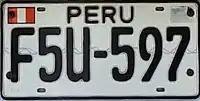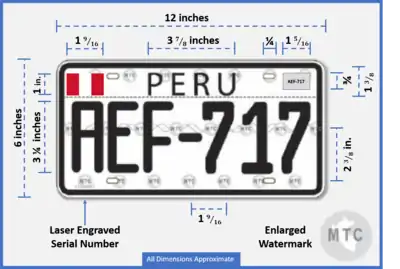Vehicle registration plates of Peru
Peru requires its residents to register their motor vehicles and display vehicle registration plates.[1] Current plates are North American standard 6 × 12 inches (152 × 300 mm).

All vehicles are required to display plates on the front and back. Peculiarly, taxis in Peru are also required to display the characters of the license plates on each side of the vehicle. This is done with a large decal.
1924 - 1973: Early plates
License plates issued up to 1973 came in a variety of colors and styles. Many years had city names placed on them which created a variety of different plates issued each year.
| Image | Year | Type | Slogan | Serial format | Serials issued | Notes |
|---|---|---|---|---|---|---|
 |
1963 | Passenger car | None | 1-23-45 | ||
 |
1966 | Passenger car | None | 12 34-56 |
1974 - 1995 Series
The first letter of these plates indicated the vehicle type, and the chart below shows the letters assigned to each type. The second letter indicated the region (or province for the City of Lima) where the vehicle was registered. The second chart below shows these codes.
| Letter(s) | Type |
|---|---|
| A,B,C,D,E,F,G,H,I,J,K,L | Automobile |
| M,N | Motorcycle, moped |
| O,P | Pickup truck |
| Q | Panel truck |
| R | Rural truck, SUV |
| S,T | Station wagon |
| U,V | Bus |
| W,X | Truck |
| Y | Tractor truck |
| Z | Trailer, semi-trailer |
| Letter(s) | Region | Letter(s) | Region |
|---|---|---|---|
| A | Tumbes | N | Cerro de Pasco |
| B | Piura | P | Junín |
| C | Lambayeque | R | Huancavelica |
| D | La Libertad | S | Ayacucho |
| E | Ancash | T | Apurímac |
| F | Ica | U | Puno |
| G,I,O,Q | Lima and Callao | V | Madre de Dios |
| H | Arequipa | W | Amazonas |
| J | Moquegua | X | San Martín |
| K | Tacna | Y | Loreto y Ucayali |
| L | Cajamarca | Z | Cusco |
| M | Huánuco |
| Image | Year | Type | Slogan | Serial format | Serials issued | Notes |
|---|---|---|---|---|---|---|
 |
1994 | Public Transport | None | ABC-123 | ||
1995 - 2009 Series
Plates issued during the years 1995 - 2009 continued to use the same format that was begun in 1975. The first letter continued to indicate the vehicle type, and the second letter indicated the region or province. These plates were black characters on a yellow background and they continued to use the same format, ABC-123, until all combinations in a region or province were exhausted. When complete, the old series was followed by plates with black characters on a white background, but they used the format AB-1234.
| Image | Year | Type | Slogan | Serial format | Serials issued | Notes |
|---|---|---|---|---|---|---|
 |
2008 | Passenger car | None | AB-1234 | ||
2010 Series

The redesign of the Peruvian plates included many changes. The national flag of Peru is displayed in color, without the shield, in the upper left hand corner. The word Peru is centered at the top in all capital letters. There is a holographic label at the top right with the plate number and nanotext, and any attempt to remove it will cause its destruction. The background to the plate has reflective sheeting which contains a high security seal (watermark). At the lower left of the plate a security serial number is laser engraved into the plate. In the background of the center of the plate is a three-dimensional interwoven sine wave. The plates are made of aluminum and are 150 mm tall by 300 mm wide except for motorcycles which are 110 mm tall by 190 mm wide. The holographic seal is also smaller on the motorcycle plates.[2]
Region and province codes
The new series of plates began to be issued in January 2010. The first character of the plate continued to designate the region or province, but the letters were reassigned to different regions. With the new plate colors representing the vehicle type, the second character no longer represented the vehicle type.[3]
| First Letter | Region(s) | Registration Area |
|---|---|---|
| A,B,C,D,F | Lima | 9 |
| E* | Not used | |
| G,I,J,K,N,O,Q,R | Reserved for future use | |
| H | Ancash | 7 |
| L | Loreto | 4 |
| M | Amazonas, Cajamarca, Lambayeque | 2 |
| P | Piura, Tumbes | 1 |
| S | San Martín | 3 |
| T | La Libertad | 5 |
| U | Ucayali | 6 |
| V | Arequipa | 12 |
| W | Huanuco, Junin, Pasco | 8 |
| X | Apurimac, Cusco, Madre de Dios | 10 |
| Y | Ayacucho, Huancavelica, Ica | 11 |
| Z | Moquegua, Puno, Tacna | 13 |
*The initial letter "E" designates plates that are in the Special category of plates (diplomatic, emergency, exhibition, government, police, rotary, and temporary).[4]
Regular Series plates
The second character of these plates first takes on a numerical value of 1 to 9 (in order) followed by the number 0, and then the letters of the alphabet in alphabetical order.[5] All vehicles now are issued the so-called "third plate" which is a windshield sticker that includes an RFID chip. The RFID chip allows the police to electronically verify the registration of the vehicle with a hand-held reader. The third plate cannot be removed from the windshield without it being destroyed.[3]
| Image | Type | Serial format | Serials issued | Notes |
|---|---|---|---|---|
 |
Automobile | ABC-123, AB1-234, A1B-234 | ||
 |
City and interurban bus | A1B-234 | Plates end in numbers 700-799. | |
 |
Interprovincial bus | ABC-123, AB1-234, A1B-234 | Plates end in numbers 950-969. | |
 |
Large motorcycle | AB-1234 | While often cited as being for mototaxis this series encompasses all motorcycles greater than 50cc or those capable of more than 50 km/h. Plates end in numbers 6000-9999. | |
 |
Small motorcycle | AB-1234 | Plates end in numbers 0000-5999. | |
 |
Taxi | A1B-234 | Plates end in numbers 600-699. | |
 |
Trailer | ABC-123, AB1-234, A1B-234 | ||
 |
Truck | ABC-123, AB1-234, A1B-234 |
Special Series plates
All Special Series plates are easily distinguished by the small letter "E," representing the Spanish word especial, as the first character at the left hand side of the plate. To prevent confusion, the letter "E" is not used to identify any region or province.[6]
| Image | Type | Serial format | Serials issued | Notes |
|---|---|---|---|---|
 |
Diplomatic | E CA-123 | CC: Consular Corps CD: Diplomatic Corps MI: International Mission TA: Technical Administrative Staff[7] | |
 |
Emergency vehicle | E UA-123 | Ambulances and fire fighting vehicles | |
 |
Exhibition | E EX-123 | Plates assigned to a vehicle before the vehicle has received its permanent registration. The letter "H" has been reserved for future use (replacing "X").[8] | |
 |
Governmental vehicles | E GA-123 | ||
 |
Police vehicles | E PA-123 | The letters "L", "M", and "N" have been reserved for future use (replacing "P")[8] | |
 |
Temporary vehicles | E ZA-123 | Plates assigned to a vehicle upon temporarily entering the country. Plates must be returned to the customs authority when leaving the country. | |
 |
Used imported vehicles | E RM-123 | Plates assigned to a used vehicle brought into the country for repair purposes or to be sold. These plates are good for a maximum of seven days. |
Papal visit

For the visit of the Roman Catholic Pope, Francis, from 18-21 January 2018, special license plates were created. These plates have all of the same security features as regular plates, but the coloring, yellow and white which are the official colors of the Holy See, the lettering, and the use of the coat of arms of the Vatican, are unique to these plates. Three license plates of the style shown here were produced. Additionally, there were 30 Exhibition plates issued for the Papal delegation.[9][10]
References
- http://www.worldlicenseplates.com/world/SA_PERU.html
- "Supreme Decree". Annex IV, Article 9, Act No. 017-2008-MTC of 19 April 2008.
- "Supreme Decree". Annex II, Article 9, Act No. 017-2008-MTC of 19 April 2008.
- "Supreme Decree". Article 10, Act No. 017-2008-MTC of 19 April 2008.
- "Supreme Decree". Article 9, Act No. 017-2008-MTC of 19 April 2008.
- "Supreme Decree". Article 10, Act No. 017-2008-MTC of 19 April 2008.
- "Supreme Decree". Annex IV, Article 22, Act No. 017-2008-MTC of 19 April 2008.
- "Supreme Decree". Annex III, Article 10, Act No. 017-2008-MTC of 19 April 2008.
- "¿Qué significan las siglas 'SCV' de la placa del 'Papamóvil'?". Perú21. 17 January 2018. Retrieved 30 September 2018.
- "Papa Francisco: Los "Papamóviles" ya cuentan con placa de rodaje y SOAT". Mediakit Grupo RPP. 18 January 2018. Retrieved 30 September 2018.